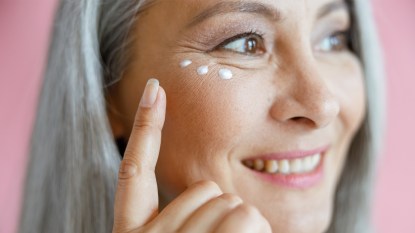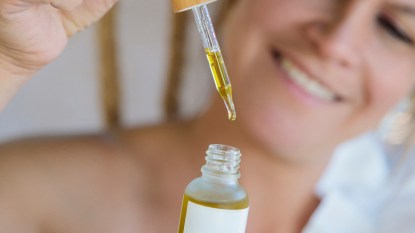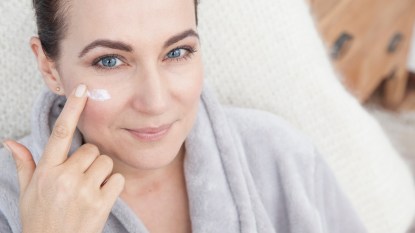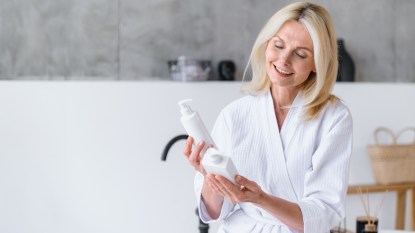Using These Two Skincare Ingredients Together Targets and Reduces Wrinkles
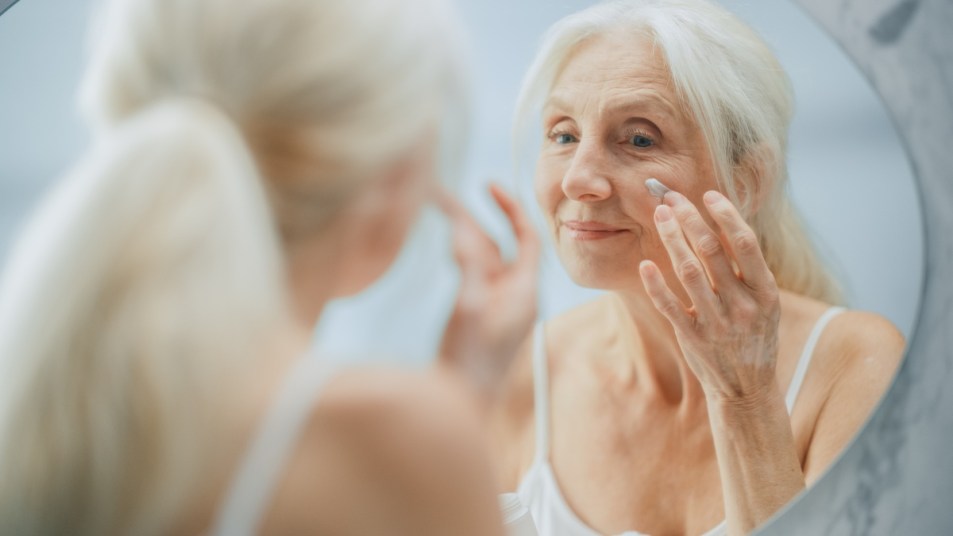
While we all search for that one ingredient that will banish fine lines and wrinkles for good, what we truly need for beautiful, plump skin is right under our noses — or it should be, anyway! Mature skin requires more TLC, and one of the best ways to achieve a healthy glow is proper hydration. With that in mind, we’re here to give you the low-down on two ingredients that perform well on just about any skin type: squalane and hyaluronic acid.
But what is the difference between these two ingredients? Does one work better than the other, and should you use them together? To better understand the world of skin hydration, we sat down with Archana Johnsen, founder and formulator of the skincare brand Forshelli, and Anna Guanche, board-certified dermatologist, celebrity beauty expert, and founder of the Bella Skin Institute.
What is squalane?
“Squalane is a skincare ingredient that is closest to our natural skin oil (sebum),” Johnsen tells Woman’s World. “It is colorless, odorless, and imparts a silky soft feel to the skin. It is light, incredibly moisturizing, and will not clog pores. It is safe to use on most skin types. Most cosmetic forms of squalane come from sugarcane or olives, making this a vegan ingredient.”
“[Squalane] has anti-inflammatory properties, which assist in reducing swelling, redness, and irritation,” adds Dr. Guanche. It’s true — according to a 2012 review published in Advances in Food and Nutrition Research, this key ingredient has antioxidant and detoxifying properties. This means it can protect skin cells from damage and help the skin eliminate toxins.
What is hyaluronic acid?
Interestingly, our bodies naturally produce hyaluronic acid. But as we age, they don’t always produce enough. “Hyaluronic acid is a macromolecule that is found throughout the body,” explains Johnsen. “It is best known for its ability to plump the skin and smooth the appearance of lines. For this reason, it is used as an injectable filler to smooth out and plump up the skin from the inside.”
What makes this ingredient so good for mature skin? “The aging process is a biological process, where there is breakdown of the naturally occurring hyaluronic acid in our tissues, creating hollowness and fine lines,” says Guanche. “Hyaluronic acid in skin care products acts as a moisturizing agent, reduces scarring, increases elasticity and collagen, and halts signs of aging.”
“Hyaluronic acid signals the skin to switch to wound healing mode,” adds Johnsen. “Regular use of topical hyaluronic acid can help the skin gradually repair itself, leading to visibly brighter, fresher, and less lined skin.”
Though this ingredient works for a wide variety of skin types, there are a few potential downsides. “There is some evidence that lower molecular weight hyaluronic acid products could lead to skin irritation in sensitive individuals,” says Johnsen. “If possible, look for products with High Molecular Weight Hyaluronic acid.”
For those of us who need a brief explanation (I know I did), a higher weight means the hyaluronic acid will sit closer to the skin’s surface, while a lower weight means the ingredient will penetrate deeper into the epidermis. Both have benefits but the higher-weighted one delivers immediate hydration, while the lower-weighted one rehydrates skin cells over time — and takes a little longer to work.
“Hyaluronic acid stays on the top layers of the skin, keeps the skin hydrated for at least 12 hours, and helps smooth the appearance of skin irregularities.”
Can you use squalane and hyaluronic acid together?
Short answer: yes! “[You may] use both hyaluronic acid and squalane in skin care products to combat the aging process,” Guanche says. “They can be used together — they do not contradict one another or cause an adverse reaction when combined. [I recommend that you] apply hyaluronic acid on the face first and then apply squalane.”
“Both ingredients are superstar ingredients for aging skin,” Johnsen agrees. “They are relatively non-reactive in the skin … They work well in tandem and can produce visible results within weeks — fresher looking skin with better texture.”
What products or ingredients do you recommend using with squalane and hyaluronic acid?
“Ingredients that work really well with this combination include niacinamide [a form of vitamin B3], which works to increase skin radiance, reduce dark spots, and increase the natural production of hyaluronic acid in the skin,” Johnsen recommends. “Fermented extracts work really well in increasing hydration levels when used with hyaluronic acid and squalane. Hydrolyzed proteins or peptides can also work very well with this combination to enhance the strength of the skin barrier. Lastly, antioxidants of any kind are fantastic for aging skin, so look for ingredients like white or green tea extracts, Q10, [and] Resveratrol.”
Together with squalane and hyaluronic acid, Guanche suggests using retinol or Retin-A, vitamin Cs, AHAs, and BHAs. “Squalane and hyaluronic acid mix well with vitamin C serums and retinols because they are “active ingredients” and mix well with moisturizing agents,” she explains.
Johnsen also notes that squalane and hyaluronic acid can soothe irritation from stronger ingredients like vitamin C and retinol. What a winning combo!
Are there any ingredients that don’t perform well when mixed with squalane and hyaluronic acid?
While our two winning ingredients tend to pair well with other add-ins and formulas, there are a few things to keep in mind. “If you use several products containing natural gums along with hyaluronic acid, you might notice some flaking or pilling,” says Johnsen. “But that can be resolved by using just one product containing these ingredients and applying a face oil on top.”
If you’re looking for a moisturizer with these key ingredients, we recommend Fleur & Bee’s H2 Oh Yeah moisturizer (Buy from Fleur & Bee, $24). It contains squalane, niacinamide, and sodium hyaluronate, or the sodium salt of hyaluronic acid (which comes with its own set of amazing skin benefits). Their Just Dew It Hydrating Serum (Buy from Fleur & Bee, $34) is also excellent, as it includes jojoba seed oil, grapeseed oil, squalane, and niacinamide.
Another one of my personal favorites? Honest Beauty’s Hydrogel Cream (Buy from Honest Beauty, $19.99). Formulated with two types of hyaluronic acid and squalane, it calms down redness and leaves my skin feeling refreshed and hydrated.
With the right combination of hydrating ingredients, we hope that you’ll love the skin you’re in.


